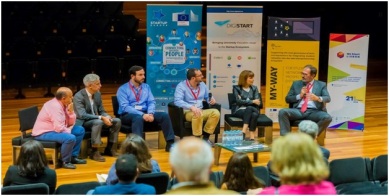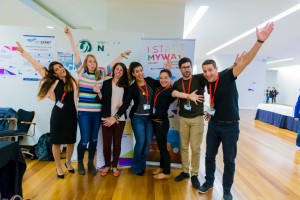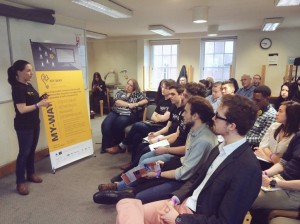When the MY-WAY project was funded in 2014, the European landscape of youth entrepreneurship was highly fragmented: although many support initiatives existed, they did not coordinate their efforts, information was lacking and young European prospective entrepreneurs were necessarily limited to their local options when searching for information and support.
The idea of MY-WAY came from talks and confidence boosting speeches on how young adults should start and develop their businesses. Listening to young people’s challenges, it became clear that connecting the stakeholders of the web entrepreneurship ecosystem (mentors, accelerators, VCs, incubators etc.) with the student networks; connecting the students with business people and connecting the available platforms and initiatives across Europe had the potential of providing all actors with an added value and increase the effectiveness of the web entrepreneurship ecosystem.
From early 2015 until the end of 2016, ten organisations from eight European countries worked as a tight-knit team to bring student organisations supporting prospective entrepreneurs back into the centre stage of the ecosystem.

Our Israeli partner, Bar Ilan University, outlined a mapping methodology to lay out the most relevant actors for a young person wishing to launch a new business. By checking the MY-WAY map, you will be able to really understand the entrepreneurship environment not only around you, but throughout Europe, and you may find the missing piece of your business and directly contact a certain organisation, such as a co-working space, an accelerator, an investor, and alike.
Later on, our partners AEGEE (the European Students’ Forum) and NACUE (the National Association of College Universities Entrepreneurs) worked together to develop, carry out and later analyse online surveys and face-to-face interviews to young prospective entrepreneurs and student support centres. Through this endeavour, partners realised that students need to have closer contact and support from support centres, which should fill the gaps between the main actors in the field of entrepreneurship, including the ones providing information and guidance and encouraging young people to develop their ideas and support the fulfilment of their dreams. On the other hand, student support centres and student networks often face financial challenges and lack of proper working space, and have fragmented relationships with each other.
All partners then scouted their own ecosystem to find successful innovative collaboration agreements between a wide range of initiatives offering support to prospective entrepreneurs. Our Set of Best Practices showed that student networks can position themselves as key actors within the web entrepreneurship ecosystem if they are connected with other actors within the ecosystem, such as entrepreneurship networks, entrepreneurship centres, universities and organisations that provide financial support.

In order to facilitate novel connections and to give voice to the other side of the equation, AEGEE and Europa Media further organised two Stakeholder Meetings in Brussels, bringing together 30-40 people of all ages, backgrounds and nationalities working in the entrepreneurship field: mentors, accelerators, student networks, incubators, investors, student support centres, and much more.
As a good number of recommendations and novel ideas was shortlisted, it became high time to give back to the students: MY-WAY managed to reach out to more than 750 students in the occasion of 5 Student Enterprise Conferences organised in London (by NACUE and Capital Enterprise), Budapest (by YES and Europa Media), Lisbon (H-Farm and Europa Media), Tel Aviv (Bar Ilan University) and Treviso (H-Farm and Europa Media).
Through the participation of our rock-star mentor and coach David Trayford, of all our partners and city-specific organisations acting in the entrepreneurial field, the events were a unique opportunity for students to discuss various topics related to how to make their business idea become real, learn more about ongoing funding programmes and initiatives, to change the mindset of those who may lack confidence and overall to make entrepreneurship a more appealing career option.

As the project comes to an end, it is time to take stock of what has been achieved and reflect on how to continue this satisfactory work. It is fair to say that partners have worked hard and in harmony for two years, driven by a unique enthusiasm and passion for helping students with their business ideas.
Being part of the Startup Europe club has further increased our outreach potential: we have established new connections with ongoing projects and initiatives, created new collaboration agreements and programmes, raised awareness on the entrepreneurial lifestyle, trained students on crucial skills and boosted their self-confidence.
By: Valentina Zuri & Krisztina Toth




























